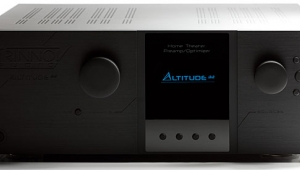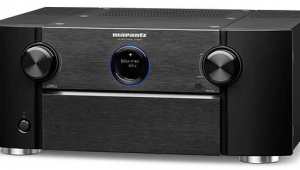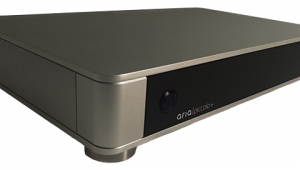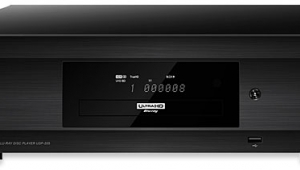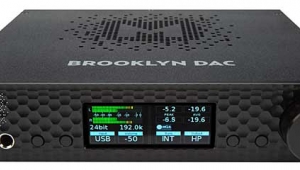| Columns Retired Columns & Blogs |
Music in the Round #27 Page 2
Sonically, the Atoll PR5.1 reminded me of the sainted Sony TA-P9000ES—and, to a degree, of the excellent Bryston SP2, though without the latter's pinpoint detailing of high frequencies. The PR5.1 could be thought of as having a slightly more relaxed and forgiving sound, one that suggested but didn't equal the lucidity and natural balance of the Cary Cinema 11 I reviewed in July. At a price comparable to the PR5.1 with DSP Option, the NHT Controller (January 2007) is a far better and more complete package, but operationally, it's a home-theater component. Music-only audiophiles will find the Atoll's operation more familiar and comfortable.
Footnote 1: What's HDMI V1.3a? I'll dive deeper into this next time, but if you can't wait, here are two explanations: nhthifi.com/2006/manuals/current/NHT-HDMI-FAQ.pdf is simple and easy to read, but less than detailed; more can be found at www.hdmi.org/learningcenter/faq.aspx#hdmi_specificationwiki/HDMI. Ultimate AV's Tom Norton reports on his experience with HDMI transmission of Dolby TrueHD and DTS-HD Master Audio at www.ultimateavmag.com/features/807hdmi13.
All this makes the Atoll PR5.1, in my experience, a unique product. The base unit is an excellent analog preamplifier that has all the inputs and outputs needed for multichannel and stereo functions, at a price lower than any other full-feature multichannel preamp. You can add the DSP Option (and ignore its outdated video options) to access DD and DTS soundtracks for music or movies without giving up any aspect of sound or function. If you're basically a two-channel audiophile but want to add an SACD and/or DVD-Audio player for multichannel, the PR5.1 is an attractive and obvious choice.
Zektor MAS7.1 Switch
As of today, as we enter the era of high-resolution digital multichannel sources, I am a proponent of analog multichannel preamplifiers and power amplifiers—so long as they maintain the traditional good performance of analog sources. But until there are significant music releases on HD DVD and/or Blu-ray, that will mean continuing to deal with SACD and DVD-Audio, and having to run six analog interconnects from player to preamp. This situation didn't improve with the releases of the first HD DVD and Blu-ray players, which were rushed to market before the availability of the HDMI 1.3 interface between source and processor. But even that assumes that the user has an HDMI input, and most audiophiles don't. As a result, I had to use the usual half-dozen analog interconnects when I installed a Blu-ray player, as reported in my September column.

How many six-channel inputs does your preamp have? One is typical, but two is possible, as in the Atoll Electronique PR5.1 described above. Does any product offer more? I think not.
However, as I reported in December 2004, the Zektor MAS3—a six-channel, three-input, $449 switcher—did the job. Since then I've used the Zektor to give me at least three 5.1 inputs and to make the swapping of preamps and processors a bit easier. It's an option I characterized, with a nod to Einstein, as "simple but not too simple."
Zektor's MAS7.1 ($599) is not quite as simple as the MAS3, but it does everything the MAS3 did and more. There still are three six-channel inputs controlled by front-panel pushbuttons. As before, the switch can learn remote codes that allow the user to control it from other remotes, but now Zektor includes a simple dedicated remote control as well. RS-232 and 12V control options are also included. Anything you could do with the MAS3 you can do with the MAS7.1, and more easily.
But the MAS7.1 is not just a better MAS3. First, it adds two more analog channels per input, making it capable of switching 7.1 channels, if you need that. Interestingly, those two additional channels can be switched independently of the other six, making the MAS7.1 a three-way stereo input selector as well. Second, the MAS7.1 has three coax and three TosLink inputs, as well as coax and TosLink outputs. These are so linked that they can be used as a three-way digital coax switch, a three-way TosLink switch, or—get this—a three-way switch with coax or TosLink digital output. That's because the selected input is always converted and available at both the coax and TosLink output jacks, regardless of the format of the input. What a boon for those with a mismatch between their digital sources and digital inputs!
But here's the main reason I got an MAS7.1: It's also a three-way HDMI switcher with HDMI V1.3a (footnote 1) capability. Turns out that, audio aside, I have three HDMI sources but only one HDMI input on my display; in the absence of an A/V receiver, the MAS7.1 is the only way I can have them all connected simultaneously. Two separate sets of pushbuttons control independent selection of HDMI and audio sources, but they can be linked by a simple button press or by programming that link in setup.
For reasons of bandwidth and (perhaps more significant) content control, the new hi-rez audio codecs, Dolby TrueHD and DTS-HD Master Audio, can be sent only via HDMI 1.3—not via digital coax or TosLink. Of course, the new HD DVD and Blu-ray players can convert one or both of these formats into PCM for output via HDMI. In addition, we're beginning to see players that will output SACD and DVD-Audio via HDMI, such as the new Oppo Digital DV-980H universal player.
The MAS7.1 can handle the job with all sources analog, coaxial digital, TosLink, or HDMI. It's the Swiss army knife of audio input switchers.
Next Time in the Round
By now, you should have good idea of where all this is going. Though it seems inevitable that many of us face a near future of multiple players for multiple formats, most likely the common denominator will be the HDMI connection on their rear panels. Yes, the new hi-def players, like the SACD and DVD-Audio players before them, will also decode most of the new formats internally for output via multiple (5.1 to 7.1) analog cables—that's how I use my Pioneer Elite BDP-HD1 Blu-ray player. Unfortunately, that strands us with the players' generally minimal bass management and nonexistent EQ capabilities. It's only a holding action until the dust settles on a new standard—which, unless I'm missing something, will be HDMI.
So, next time in the Round, I'll begin with a brief report from September's CEDIA Expo, and follow it with a description of my experience with the Esoteric DV-60 universal disc player. Then, with some trepidation, I will cross the line into the realm of HDMI audio with Oppo's DV-980H universal player and Integra's DTC-9.8 preamp-processor. Look, Ma—only one cable!.
Footnote 1: What's HDMI V1.3a? I'll dive deeper into this next time, but if you can't wait, here are two explanations: nhthifi.com/2006/manuals/current/NHT-HDMI-FAQ.pdf is simple and easy to read, but less than detailed; more can be found at www.hdmi.org/learningcenter/faq.aspx#hdmi_specificationwiki/HDMI. Ultimate AV's Tom Norton reports on his experience with HDMI transmission of Dolby TrueHD and DTS-HD Master Audio at www.ultimateavmag.com/features/807hdmi13.
- Log in or register to post comments


